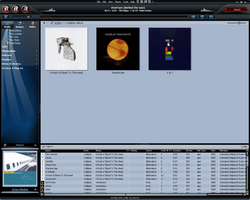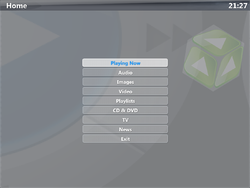- Media Center (software application)
-
This article is about the application by JRiver. For the Microsoft application, see Windows Media Center. For treatment of media centers in general, see Media center.
Media Center Developer(s) JRiver Initial release 1998 Stable release 16.0.181 (October 29, 2011) [+/−] Preview release none (none) [+/−] Written in ? Operating system Windows Available in Albanian, Chinese, Czech, Dutch, English, British English, French, German, Greek, Italian, Japanese, Korean, Portuguese, Romanian, Spanish Type Media player License Proprietary Website jriver.com Media Center, or formally, "JRiver Media Center" is a multimedia application that allows the user to play and organize various types of media on a computer running Windows.
Media Center is a "jukebox"-style media player, like iTunes, which usually uses most of the screen to display a potentially very large library of files.
Regular, usually daily beta builds are posted on the Media Center Interact forum implementing requested features and fixing reported bugs. The forum has an active user community, more than 25,000 users as of 2011.
Also available for Media Center are an Audioscrobbler plugin, and G-Force, a popular visualisation.
It can also rip CDs, and burn them. MediaCenter also supports static and dynamic playlists.
Contents
Library system
Media Center organizes files using Media Libraries, these are effective databases. Media Center can support multiple libraries.
Information relating to media is imported into the library including meta data for media files and the path to the media files. The media files themselves are not contained in the database, but cataloged within the libraries.
Version 12 of Media Center added support for auto-importing of media, whereby Media Center continually watches designated directories for changes in media. If a new file is dropped into the directory, Media Center will add the file to its library. Each library can contain any type of media, video, audio, images etc.
View Schemes
View Schemes are the main way to browse through files in Media Center. Views can be created which help users see different parts of their library; these are effectively the same as database views. They are based on using metadata as criterion for creating a filtered list of files.
The view system is very powerful and fully customizable. For example, a view could be made which shows only audio files in MP3 format which are longer than 3 minutes, or images taken in Africa in the year 2006.
For ease of use, several default views exist which show files of a specified type only, including: audio, images, or video.
Various View Items, or panes, can be moved to the top, left, right, or in dropdown menus, that can be used to further filter results. For example, one of the default views, artist/album, allows selecting a specific artist or album, or both, and shows files from that album or artist only.
Once a view is created, it is automatically saved in the library and can be opened in the various user interfaces, and searched using a real-time search box. The searches are very customizable, possible on any field or tag in the library.
Playlists
Media Center allows the creation of playlists. It also can export playlists as M3U or ASX,
Smartlists
SmartLists are similar to playlists except that rather than selecting a list of songs, the list is governed by a set of rules. For example, a smartlist might take every video file which was produced in 1994. Smartlists can be based on Playlists. They are defined using an expression language. Media Center provides a wizard style dialogue box to simplify creating these.
An added benefit of a smartlist over a standard playlist is that a smartlist is dynamic; it will update itself whenenever new files that meet its criteria are added to the library. For example, one could create a smartlist to show all tracks with the genre tagged as Indie Rock. If a new album were added to Media Center's library that had the Indie Rock genre tag, Media Center would automatically add those files to the smartlist.
User interfaces
Media Center provides four different user interfaces for use in different situations. Each user interface is skinnable.
Standard View
Standard View is the default user interface for looking at the Media Center Library on a desktop/laptop computer. It is also the most powerful interface, allowing access to features such as:
- Tagging
- Ripping
- CD/DVD burning
- Accessing portable players
- Creating/editing playlists, smartlists, and views
- Setting up TV stations
- Accessing web media
Standard view uses a large amount of screenspace. It can be viewed full screen or as a window.
The standard view consists of the following components:
- Tree: allows navigating different views of the Media Library
- Action Window: allows quick access to the more common tasks such as ripping/burning
- Header area: contains the player controls for changing track positions, and media control
- Playing Now Area: the current playlist which is playing
- Panes/Thumbnails: allows selection/viewing media
- Tagging Panes: allows tagging media
Theater View
While the standard and mini views are designed to be used in front of a desk computer, or laptop, Media Center also features a large font remotely accessible 'Theater View'.
This is made to work on a large screen, such as a television, projector or large computer screen. The interface is made to work in in a 10-foot mode, i.e. from a living room sofa using remote controls, rather than the conventional mouse and keyboard.
As of Media Center 12, Theatre view relies on Microsoft's DirectX graphics engine. With this, Media Center uses 3D and 2D Animation to create a more visually appealing interface, which more nearly resembles that of a digital recording box, or DVD player.
The Theater View doesn't provide the editing interfaces of standard view, but instead provides much more accessible access to the different views of the library. All the buttons in Theater View are large, and tend to move to different pages to display different information.
Theater View also provides access to the Weather, News Websites and RSS Feeds.
Mini View
Mini view is similar to that of Winamp. It's designed to take up minimal screen space while still providing access to basic controls. The mini view skins are different from the other user interface skins seen in Media Center in that JavaScript can be placed behind them to make them more dynamic. Mini views are far more flexible than the other types of skins, allowing Media Center to take various shapes and forms using transparency effects.
Networking
Media Center provides network access to its libraries using different server plugins.
Library server
Library server allows Media Center to share its active library with up to five client machines. This is designed for situations where a server machine with large resources is set up in one area, and clients such as laptops with smaller resources can access media elsewhere.
Tivo Server
Media Center supports TiVo's Home Media option, allowing TiVo to stream video and audio.
UPNP and DLNA servers
Web Services Integration
- Audible
- Amazon MP3 Store
- CDBaby
- Hulu
- MediaNet Digital
- Netflix
- Youtube
Plugins
Media Center uses COM Support to provide access to an SDK library. This allows plugins to be written in a wide variety of languages including:
- C++
- C#
- Object Pascal (Delphi)
- Visual Basic
There are many different types of plugins that can be created for different purposes:
- Theater View plugins: allows creating extensions to Theater View
- Interface plugins: allows interface extensions for Standard View
- DSP plugins: allows directly manipulating sound processing
- Display plugins: allows creating different Visualisations
- Input plugins: can be used to add new formats to Media Center, which are not supported natively
It is also possible to create "Track Info" visualisations that are created in HTML to display information about the currently playing Media. These can be extended further using the various web languages around such as JavaScript.
A full list of plugins are available here: [1]
Media formats
Media Center supports a wide range file formats among audio files, video files, photos and documents. A full lists of supported formats can be found on the JRiver Media Center wiki; (supported audio formats, supported video formats, and supported image formats). DirectShow is supported, allowing the playing of any video or audio format for which a DirectShow Filter is available, and installed.
Handheld and other hardware devices
- Android
- iOS: iPad, iPhone, iPod Touch
- Digital camera
- Image scanner
- Removable media
- Smartphone
- TiVo
- Universal Plug and Play (UPnP)
- Digital Living Network Alliance (DLNA)
Scheduler
Media Center provides a scheduling tool which allows playing/recording of media at certain times.
Media Jukebox
Media Center's predecessor was named Media Jukebox, until the rebranding to Media Center for version 9. In November 2007, J. River released Media Jukebox 12, a stripped down version of Media Center 12, which is available to download for free, compared to Media Center's price of $49.98. Media Jukebox includes most of the audio features of Media Center; the image and video functions are removed. It is in version 14 as of September 11, 2010.
See also
External links
Home theater PC software and related devices Windows Beyond TV · GB-PVR · Meedio · MediaPortal · J. River Media Center · ShowShifter · Windows Media Center · XBMCMac OS X Linux Cross-platform Set-top boxes/
Digital media receiversApple TV · DBox2 · Dreambox · HP MediaSmart Connect · Hauppauge MediaMVP · Google TV · Netgear Digital Entertainer · Roku · TiVo · Vu+ · WD TV · Windows Media Center ExtenderRelated hardware ATI Theater Cards · Elgato EyeTV devices · Hauppauge Computer Works WinTV PVR Cards · HDHomeRun · Remote control (Touchscreen) · Mac Mini · Nvidia TV-Tuner Cards · Quiet PCSystem manufacturers Alienware · Apple Inc. · Dell · Gateway · Hewlett-Packard · Intel · Logitech · Interact-TV · Shuttle Inc. · Sony (VAIO series) · Toshiba · Velocity Micro · Zotac ·Related articles Categories:- IPod software
- Windows media players
- Windows software
- Windows-only software
- Windows CD/DVD writing software
- Jukebox-style media players
Wikimedia Foundation. 2010.


